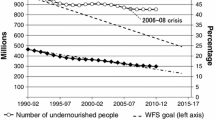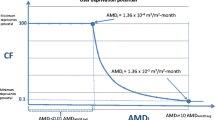Abstract
The paper explores the contribution of different factors affecting water use efficiency (WUE) of each sector and explores ways to improve WUE. A new Multi-Sector and Multi-Factors Logarithmic Mean Divisia Index (MLMDI) decomposition method was developed that enabled the identification of WUE by sector into 11 factors in terms of their order of importance. An application to Beijing at the 19 sector level was made for the period between 2002–2007. The water conservation effects of six measures proposed during the 12th-Five-Year-Plan of Beijing were assessed. It was found that, to decrease the transferred out and export of agriculture products and increasing water prices would be the top two most effective measures to promote water conservation. While the adjustment of direct water use structure would contribute in less significant way, the adjustment of industrial structure would have a negative effect.
Similar content being viewed by others
References
Hamdy A, Water use efficiency in irrigated agriculture: An analytical review, Eds. by Lamaddalena N, Shatanawi M, Todorovic M, Bogliotti, and Albrizio R, Water Use Efficiency and Water Productivity: WASAMED Project, Bari: CIHEAM, 2007, 9–19.
Gleick P H, Soft water pathes, Nature, 2002, 418(25): 373.
Xia J, Letter from IWRA President Jun Xia, Water International, 2010, 35(3): 247–249.
Chen W, Zhu S J, and Lai M Y, What induced the decline of water intensity in Chinese industries: 1996 to 2006?, 2010 International Conference on Management Science & Engineering (17th), Melbourne, Australia, 2010, 24–26.
Gleick P H, Water use, Annual Review of Environment and Resources, 2003, 28: 275–314.
Gleick P H, A look at twenty-first century water resources development, Water International, 2000, 25(1): 127–138.
Lofting E M and Mcgauhey P H, Economic valuation of water, An Input-Output Analysis of California Water Requirements, University of California Water Resources Center, Berkeley, 1968.
Xie M, Nie G S, and Jin X L, Application of an input-output model to the Beijing urban wateruse system, Chinese Economic Planning and Input-Output Application, Eds. by Karen R P and Chen X K, Oxford University Press, Oxford New York and Hong Kong, 1991, 239–256.
Chen X K, Shanxi water resource input-occupancy-output table and its application in Shanxi province of China, Thirteenth International Conference on Input-Output Techniques, Macerata, Italy, 2000, 21–25.
Bouhia H, Water in the Macroeconomy: Integrating Economics and Engineering into an Analytical Model, Aldershot, UK: Ashgate Publishing Limited, 2001.
Duarte R, Cho’liz J S, and Bielsa J, Water use in the Spanish economy: An input-output approach, Ecological Economics, 2002, 43(1): 71–85.
Vela’zquez E, An input-output model of water consumption: Analyzing intersectoral water relationships in Andalusia, Ecological Economics, 2005, 56(2): 226–240.
Liu X L, By sector water consumption and related economy aalysis integrated model and its application in Hai River Basin, China, Journal of Water Resource and Protection, 2012, 4(5): 264–276.
Wang K, Analysis of impact factors of water use based on IPAT equation for Gansu Province, Chinese Journal of Population Resources and Environment, 2011, 6: 148–152.
Ma H L, Huang D C, Zhang J G, et al., The provincial differences of water use efficiency in recent years: Technological progress or technical efficiency, Resources Science, 2012, 34(5): 794–801.
Sun C Z, Wang Y, and Li H X, Impacting factor analysis of water use efficiency in Liaoning, Journal of Economics of Water Resources, 2009, 27(2): 1–5.
Wang X J and Li Z H, Irrigation water use efficiency and its impacting factor analysis, Chinese Rural Economy, 2005, 7: 11–18.
Tan F, Cui Y L, and Wang J Z, Impact factors of irrigation WUE based on principal component analysis, case from Zhanghe irrigation district, China Rural Water and Hydropower, 2009, 2: 70–73.
Wang X Y and Zhao L G, Agricultural water use efficiency and its impacting factor in China-SFA analysis based on 1997–2006 provincial panel data, Problems of Agricultural Economy, 2008, 3: 10–18.
Molden D, Bin D, Loeve R, et al., Agricultural water productivity and savings: Policy lessons from two diverse sites in China, Water Policy, 2007, 9 (1): 29–44.
Molden D, Oweis T Y, Pasquale S, et al., Pathways for increasing agricultural water productivity, Ed. by Molden D, Water for Food, Water for Life: A Comprehensive Assessment of Water Management in Agriculture, Earthscan/IWMI, London, UK/Colombo, Sri Lanka, 2007, 279–310.
Terry A H, Enhancing water use efficiency in irrigated agriculture, Agronomy Journal, 2001, 93(2): 281–289.
Hoekstra R and Van der Bergh J C J M, Comparing structural and index decomposition analysis, Energy Economics, 2003, 25(1): 39–64.
Shapley L, A value for n-person games, Ed. by Kuhn H W and Tucker A W, Theory of Games, 1953, 2: 307–317.
Rose A and Casler S, Input-output structural decomposition analysis: A critical appraisal, Economic Systems Research, 1996, 8(1): 33–62.
Ang B W and Choi K H, Decomposition of aggregate energy and gas emission intensities for industry: A refined divisia index method, The Energy Journal, 1997, 18(3): 59–73.
Dietzenbacher E and Los B, Structural decomposition techniques: Sense and sensitivity, Economic Systems Research, 1998, 10(4): 307–324.
Ang B W, Zhang F Q, and Choi K H, Factorizing changes in energy and environmental indicators through decomposition, Energy, 1998, 23(6): 489–495.
De H M, A structural decomposition analysis of pollution in the Netherlands, Economic Systems Research, 2001, 13(2): 181–196.
Jordi R and Monica S, Income growth and atmospheric pollution in Spain: An input-output approach, Ecological Economics, 2007, 63(10): 230–242.
Johan A, Delphine F, and Koen S, A shapley decomposition of carbon emissions without residuals, Energy Policy, 2002, 30(9): 727–736.
Huang J P, Industrial energy use and structural change: A case study of the People’s Republic of China, Energy Economics, 1993, 15: 131–136.
Sinton J E and Levine M D, Changing energy intensity in Chinese industry: The relative importance of structural shift and intensity change, Energy Policy, 1994, 22(3): 239–255.
Ang B W, Decomposition analysis for policymaking in energy: Which is the preferred method, Energy Policy, 2004, 32(9): 1131–1139.
Ang B W, The LMDI approach to decomposition analysis: A practical guide, Energy Policy, 2005, 33(7): 867–871.
Chen X K, Input-occupancy-output analysis and its application in China, The Current State of Economic Science, 1999, 1: 501–514.
Gao Y Y, Wang H R, Han L J, et al., Consciousness of water resources crisis and the innovation of the water resources management system in Beijing, Resources Science, 2010, 32(2): 274–281.
Duan Z G, Hou Y P, and Wang Q W, Beijing industrial sectors water consumption analysis, Industrial Technology & Economy, 2007, 26(4): 47–49.
Xu Z J, The study on water consumption trend and strategies on industry & main industries in Beijing, Beijing Institute of Civil Engineering and Architecture Master Degree Thesis, 2006.
Wang Y, Chen Y S, and Jiang Y L, Characteristic analyze of public domestic water of Beijing city, Water & Waste Water Engineering, 2008, 34(11): 138–143.
Zhang Z Y, Shi M J, Yang H, et al., An input-output analysis of trends in virtual water trade and the impact on water resources and uses in China, Economic Systems Research, 2011, 23(4): 431–446.
Jia S F and Zhang S F, Response of industrial water use to water price rising in Beijing, Journal of Hydraulic Engineering, 2003, 4: 108–113.
Wei Y P, Chen D L, and Li B G, Effectiveness of agricultural water pricing on solving the water shortage of north China Plain: A case study in Fengqiu county of Henan province, Resources Science, 2007, 29(2): 40–45.
Teresa W, Julia K, and Daniel T, Improving water use efficiency under worsening scarcity: Evidence from the middle Olifants Sub-basin in South Africa, ZEF-Discussion Papers on Development Policy, 2010, No. 143, www.zef.de/fileadmin/webfiles/downloads/zef_dp/zef_dp_143.pdf.
Mu Z R and Yang C H, Optimizing China’s export structure combining goal programming and non-competitive input-output model, Journal of Systems Science and Complexity, 2014, 27(4): 712–728.
Liu S, Water pricing towards sustainability of water resources: A case study in Beijing, LUND University, Master’s Thesis, LUND, Sweden, 2000, 36: 42–43.
Zhang J W, Hassani H, Xie H B, et al., Estimating multi-country prosperty index: A twodimensional singular specturum analysis approach, Journal of Systems Science and Complexity, 2014, 27(1): 56–74.
Author information
Authors and Affiliations
Corresponding author
Additional information
This research was supported by the National Natural Science Foundation of China under Grant Nos. 71173210, 71473244, and 61273208.
This paper was recommended for publication by Editor YANG Cuihong.
Rights and permissions
About this article
Cite this article
Liu, X., Hewings, J.D.G., Chen, X. et al. A Factor Decomposing Model of Water Use Efficiency at Sector Level and Its Application in Beijing. J Syst Sci Complex 29, 405–427 (2016). https://doi.org/10.1007/s11424-016-3127-7
Received:
Revised:
Published:
Issue Date:
DOI: https://doi.org/10.1007/s11424-016-3127-7




